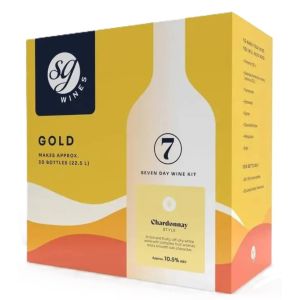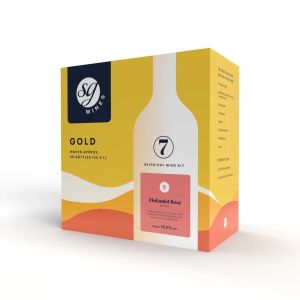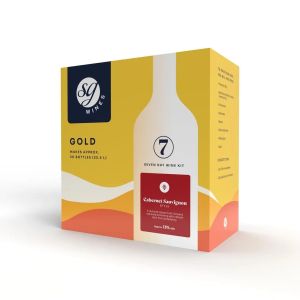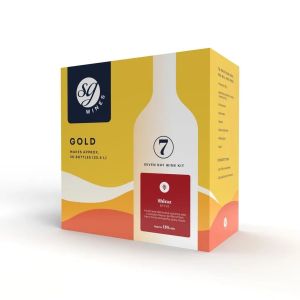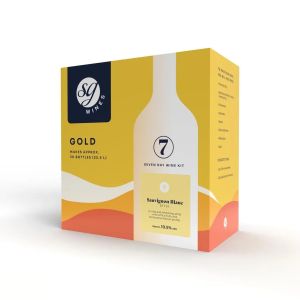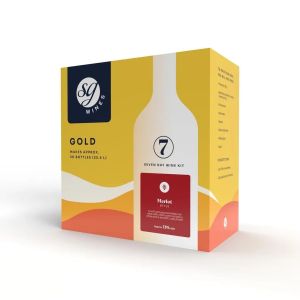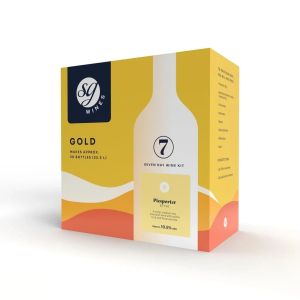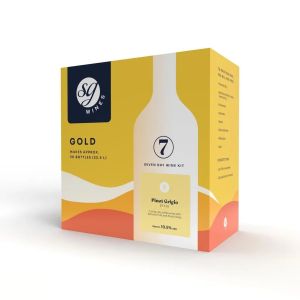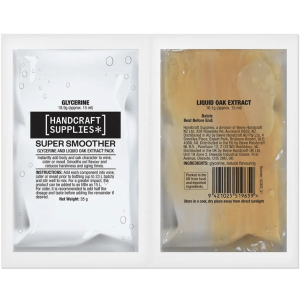SG Wines Gold Wine Kits 30 Bottle
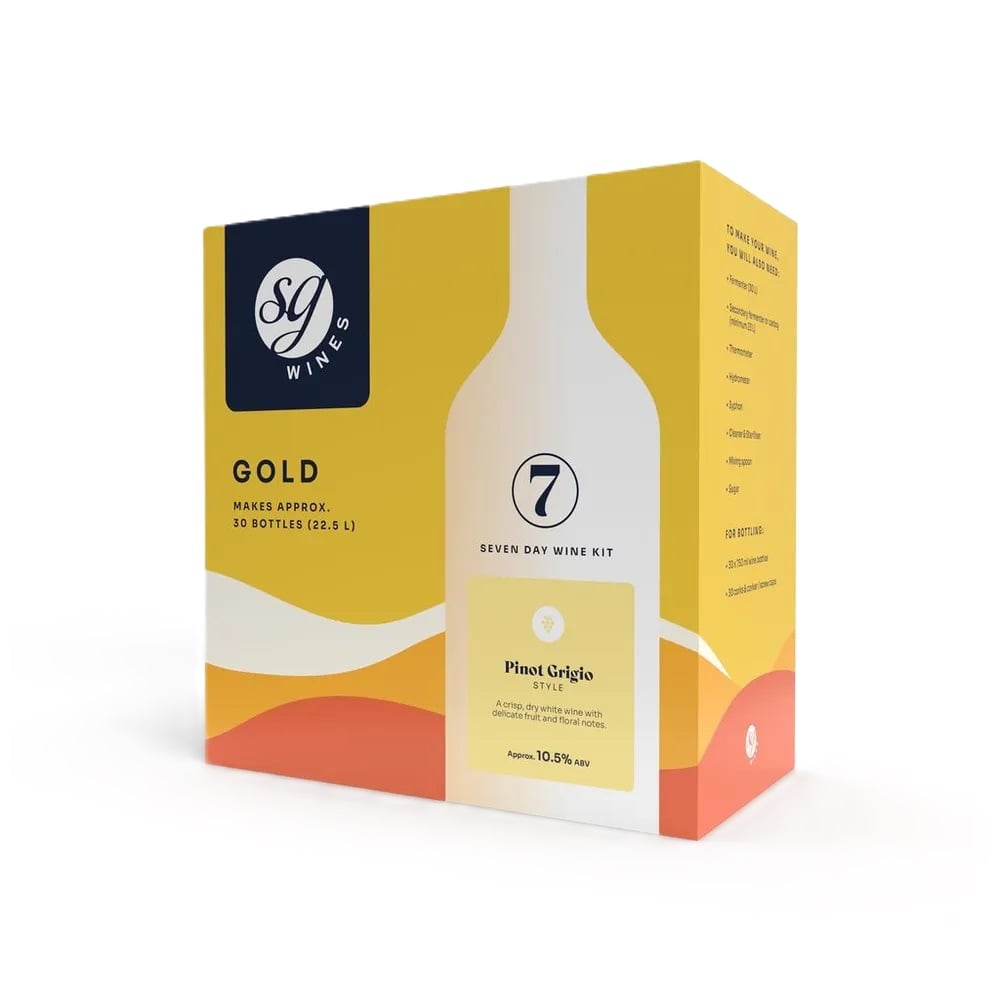
-
-
- Cabernet Sauvignon Wine Kit | 30 Bottle | SG Wines Gold£21.42 £17.85
-
-
- Merlot Wine Kit | 30 Bottle | SG Wines Gold£21.42 £17.85
-
-
-
- Super Smoother | Wine - Cider - Mead£2.16 £1.80
SG - Solomon Grundy
SG - Wine Kit Instructions - 30 Bottle - 22.5 Litre - Wine Kits
Make sure all your equipment is thoroughly cleaned and sterilised before starting.
We recommend you use Cleaner/Steriliser. Follow the manufacturers instructions.
Wine Kit - Starting Fermentation
Pour 5 litres (9 pints) boiling water into a 25 litre fermenter.
Add 3 kilos (6.6lbs) of white sugar for White and Rosé wines, and add 4 Kilos (8.8lbs) of white sugar for Red wines, and stir to dissolve. Once dissolved, add the large bottle/can of concentrate (do not add the specially concentrated wine compound at this stage), then rinse out any remains with cold water.
Top up to 22.5 litres (5 gallon) with cold water, then add sachets of Wine Yeast and Yeast Nutrient. Stir well until the yeast particles disappear then fit bung and airlock (half fill with cold water). Transfer fermenter somewhere warm between 24º-30ºC (76º-86ºF) to ferment for 5 days - fermentation will take several more days to complete at lower temperatures, but will produce a better quality wine.
WHAT TO DO AT THE END OF FERMENTATION
You must have a hydrometer if you want to make your wine in 7 days. If the hydrometer reads below 995 then you are ready to proceed. If you do not have a hydrometer, wait until the airlock stops bubbling and taste the cloudy wine to make sure it is dry before adding the sachets referred to below. Do not continue until you are sure fermentation is complete.
Once fermentation is complete, add the sachets of Stabiliser and Wine Finings A (and sachet of Sweetener if making medium sweet wine kit). Stir vigorously for at least 2 minutes to remove all gas (this is important for rapid clearing), then leave to stand for 1 hour. All stabilisers give off gas when added to wine, do not inhale this.
It is now important that the wine is fully de-gassed before continuing, this is important for rapid clearing.
The best way of de-gassing you wine is to use a Ritchie Degasser drill attachment available from most
homebrew shops. Or transfer the gassy wine from bucket to bucket 10 times, the action of pouring will remove the gas. Alternatively, the wine can be stirred vigorously - but make sure this is done for long enough to remove all the gas (usually takes at least 5 full minutes of stirring).
WHAT TO DO 1 HOUR LATER
Add the sachet of Wine Finings B and stir gently for 30 seconds, then leave to stand for a further 1 hour.
WHAT TO DO AFTER ANOTHER 1 HOUR
Add the sachet of Wine Finings C and the sachet of Wine Compound and stir well for a further 30 seconds. Leave to stand somewhere cool, this will normally take 1 day.
WHAT TO DO WHEN YOUR WINE IS CLEAR
Carefully syphon the clear wine into another 25 litre container, taking care not to disturb the sediment. You are now ready to sweeten your wine. The table below gives recommended sugar additions. We suggest you add only 2/3 or 3/4 of these amounts to begin with, stir fully to dissolve then taste. More sugar can then be added in small additions until your preferred level of sweetness is found. Remember, you can always sweeten your wine further, but can never make it drier!
TYPE Recommended Sugar addition per 22.5 Litre (5 gallons)
Chardonnay 112g (4oz)
Piesporter 180g (6½oz)
Blush 400g (14oz)
All other types add sugar to taste.
WHAT FERMENTATION TEMPERATURE?
Aim for between 21-26ºC (70-79ºF) for optimum quality. Higher temperatures will result in a lower quality wine because more off flavours are produced. Temperatures down to 15ºC (59ºF) can be used but will extend the fermentation time.
Sterilising your Wine equipment
It is important to kill any germs which might come into contact with your wine, otherwise these germs might develop and produce off-flavours spoiling your wine. Most sterilising products are powdered and contain chlorine as the active sterilising agent. Read instructions carefully before using sterilising agents (remember to rinse equipment thoroughly after sterilisation). Needless to say the VWP Cleaner/Steriliser is excellent and is highly recommended.
Syphoning Make sure the wine is crystal clear before syphoning. Clearing will usually take 1-2 days but can take longer depending upon temperature and how much gas remains dissolved in the wine. Your syphon tube should consist of a 600mm (24”) length of rigid plastic tube attached at one end to a cup or U bend (so sediment is not drawn up) the other end of the rigid plastic tube should be pushed inside a 13mm ( 1/2”) diameter plastic tubing by approx.
1500mm ( 5’ ) long. A tap can be attached to control the flow, also you may fit a clip to fix the rigid tube to the fermenter. The top of the container you are syphoning into should be lower than the bottom of the fermenter containing the wine.
Place the rigid syphon tube about 1/4 the way down into the wine, drop the flexible end down as low as possible then suck hard to start the flow. Keep sucking until the wine is halfway down the flexible part of the tube then place in relevant container.
Once flowing, drop the rigid part of the tube down to within 2-3cm of the sediment, now secure the rigid tube with a clip if possible. Tilt the fermenter to get the last wine out, dropping the syphon tube down a little further if required. Do not disturb the sediment at the bottom at any time. Leave to re-settle for a few hours if the sediment is disturbed. The best syphon on the market is the Auto Syphon.
Bottling The Wine
Once the wine is clear either bottle or syphon the wine into a bag/box dispenser.
Bag dispensers allow a glassful of wine to be drawn off at a time without risk of oxidation and spoilage of the wine. The bag should be sterilised and rinsed thoroughly before syphoning the wine. Expel any remaining air from the bag before fitting the cap.
If using bottles, we recommend plastic stoppers which allow wine to be stored upright, can be sterilised properly and easily inserted into the bottles. Both bottles and stoppers should be sterilised and rinsed thoroughly before use, then filled to approx. 50mm ( 2”) from the top before sealing with stoppers. Capsules and labels can then be applied.
For storage of wine for longer periods use good quality corks. These should be soaked overnight in sterilising solution and rinsed before inserting into the wine bottle with a corking machine. Again capsules and labels can then be applied.
The newer waxed corks can be used immediately as they don’t need soaking.
FERMENTATION DOES NOT SEEM TO HAVE STARTED?
Check the surface of the liquid for bubbles, if bubbles are visible then fermentation has started. If your airlock is not bubbling, check there is not a leak between airlock and container.
YOU ARE NOT SURE WHETHER FERMENTATION IS COMPLETE?
If you do not have a hydrometer, it can be difficult to tell whether fermentation has finished. If in doubt wait a few extra days, this will not effect the wines quality in any way. To be absolutely sure fermentation has finished, you should make sure that;
- The wine tastes bone dry (sipping cloudy wine is not harmful)
- The airlock has stopped bubbling
- The wine has started to clear (difficult to tell for red wines)
- No more bubbles rise to the surface.
FERMENTATION IS NOT COMPLETE IN 5 DAYS?
Fermentation can take longer than 5 days if the temperature has been below 21ºC (70ºF) and/or if the temperature has fallen suddenly at night. A longer fermentation time will not affect quality, do not continue to add stabiliser etc. until you are certain fermentation is complete.
THE WINE WILL NOT CLEAR?
This can happen if the temperature is too high or if insufficient gas was removed at the end of fermentation. Usually, the wine will clear if left for a few more days. If the wine has not cleared after 7 days then syphon off into another container add 5 teaspoons of Campden Powder (or 1/2 teaspoon sodium metabisulphite) and further wine finings.

